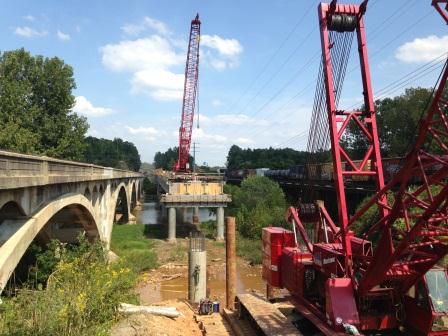Project News
Completed Yadkin River Bridge Project Wins CAGC Award

 The I-85/Yadkin River Bridge project in North Carolina, constructed by the Flatiron-Lane joint venture team, earned the 2013 Carolinas Associated General Contractors Pinnacle Award, considered the most prestigious transportation award in the state’s construction industry. Flatiron received the award in the category for best highway and transportation project at the CAGC annual conference on February 1.
The I-85/Yadkin River Bridge project in North Carolina, constructed by the Flatiron-Lane joint venture team, earned the 2013 Carolinas Associated General Contractors Pinnacle Award, considered the most prestigious transportation award in the state’s construction industry. Flatiron received the award in the category for best highway and transportation project at the CAGC annual conference on February 1.
“We are very proud of this project and the partnerships that were forged among Flatiron, our JV partner Lane, our design team STV/HDR, and owner NCDOT. All of the partners worked as a team to complete the project successfully recognizing how critically important this I-85 corridor is for the safety of the traveling public and the state of North Carolina,” said Ted Kirk, Flatiron’s southeast regional manager.
The I-85/Yadkin River Bridge project involved reconstructing a deteriorating, 55-year-old segment of North Carolina’s Interstate 85 over the Yadkin River near Salisbury, NC – relieving a significant highway bottleneck while bolstering economic development and improving safety. The project included designing and constructing a new dual 2,500 foot long I-85 bridge using a single temporary work bridge, while causing minimal disruption to I-85 traffic.
 While the main portion of the project was completed in May 2013, Flatiron crews continued work for most of the year on the nearby SR 29/70 bridge. Crews replaced the two-lane bridge approximately 2,000 feet upstream from the Yadkin Bridges, which is 873 feet long and nearly 36 feet wide.
While the main portion of the project was completed in May 2013, Flatiron crews continued work for most of the year on the nearby SR 29/70 bridge. Crews replaced the two-lane bridge approximately 2,000 feet upstream from the Yadkin Bridges, which is 873 feet long and nearly 36 feet wide.
“It’s a small portion of the contract, but it’s a fairly complicated project,” said project manager Chris Lamm. “We originally planned to build it top-down, but we’ve installed a trestle and are doing a more traditional type of construction.”
The bridge is wedged between a 1920s arch bridge and a railroad bridge. There is also an overhead power line between the site and the railroad bridge. In addition to the cramped quarters, crews dealt with an unusually wet summer and restrictions from the lack of availability for additional railroad flagmen.
“With the linear nature of the work, there is little you can do to get ahead. The next step always relies on the step you’re working on. You have to think five or six steps ahead,” said Chris.
